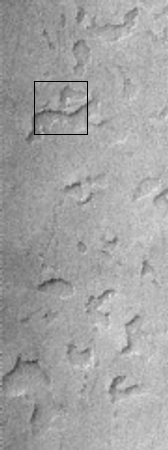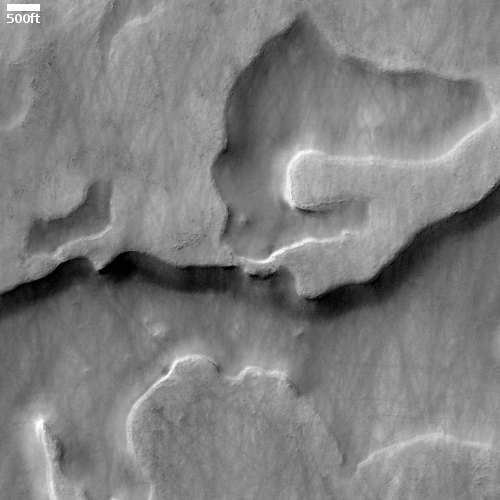Mars’ icy high latitudes
Cool image time! The photo to the right, rotated, cropped, and reduced to post here, was taken on November 29, 2020 by the high resolution camera on Mars Reconnaissance Orbiter (MRO). Labeled simply as “periglacial survey,” it is one of almost two hundred such images taken by MRO over the years, almost all of which are in the high latitudes above 60 degrees, with most being in the southern hemisphere. Most appear to be close to or above Mars’s Arctic Circle, which means these are locations that will see little or no sunlight for a portion of the year.
I have been unable to contact the scientists doing this survey, so I will have to make an educated guess as to its purpose and goals. “Periglacial” refers to the outer fringes or margin of a glacier or large ice sheet. Thus, in the context of this survey, the scientists appear to be studying places where they think the Martian high latitude ice sheets are beginning to sublimate away. Today’s photo is a good example. It is located at 67 degrees south latitude, in the southern cratered highlands but in an area that appears to be relatively free of craters. Instead, the terrain appears somewhat flat with only periodic depressions and scarps. The MRO context camera photo below of the same area, rotated, cropped, and expanded to post here, illustrates this.

Click for full image.
The black box marks the area covered by the close-up photo. As you can see, what looked like an east-west channel in the close-up was merely a longer enclosed depression.
In fact, the whole region reminds me of what you see if you finely spray hot water on a sheet of ice. Patches begin to melt away randomly, producing holes and depressions.
In the close-up one also gets the strong sense that everything here is either frozen ice or is dust and dirt that is impregnated within it, so much so that everything has become smoothed as the ice has gone through numerous cycles of freezing and sublimation over the eons. There are no dunes, and though the dark streaks indicate dust devil tracks there certainly appears to be little surface dust.
The photo and its features, as well as this entire periglacial survey, strongly invokes a vision of a very icy Mars in its high latitudes. While scientists have found many glacial features in the latitude bands from 30 to 60 degrees latitude, what this photo suggests is that at higher latitudes the ground is almost entirely covered by an ice sheet.
As I’ve said before, Mars is a desert like Antarctica, icy, cold, and very dry. In building future colonies that coldest place on Earth probably gives us the best analogy for the environment on Mars.
On Christmas Eve 1968 three Americans became the first humans to visit another world. What they did to celebrate was unexpected and profound, and will be remembered throughout all human history. Genesis: the Story of Apollo 8, Robert Zimmerman's classic history of humanity's first journey to another world, tells that story, and it is now available as both an ebook and an audiobook, both with a foreword by Valerie Anders and a new introduction by Robert Zimmerman.
The print edition can be purchased at Amazon or from any other book seller. If you want an autographed copy the price is $60 for the hardback and $45 for the paperback, plus $8 shipping for each. Go here for purchasing details. The ebook is available everywhere for $5.99 (before discount) at amazon, or direct from my ebook publisher, ebookit. If you buy it from ebookit you don't support the big tech companies and the author gets a bigger cut much sooner.
The audiobook is also available at all these vendors, and is also free with a 30-day trial membership to Audible.
"Not simply about one mission, [Genesis] is also the history of America's quest for the moon... Zimmerman has done a masterful job of tying disparate events together into a solid account of one of America's greatest human triumphs."--San Antonio Express-News
Cool image time! The photo to the right, rotated, cropped, and reduced to post here, was taken on November 29, 2020 by the high resolution camera on Mars Reconnaissance Orbiter (MRO). Labeled simply as “periglacial survey,” it is one of almost two hundred such images taken by MRO over the years, almost all of which are in the high latitudes above 60 degrees, with most being in the southern hemisphere. Most appear to be close to or above Mars’s Arctic Circle, which means these are locations that will see little or no sunlight for a portion of the year.
I have been unable to contact the scientists doing this survey, so I will have to make an educated guess as to its purpose and goals. “Periglacial” refers to the outer fringes or margin of a glacier or large ice sheet. Thus, in the context of this survey, the scientists appear to be studying places where they think the Martian high latitude ice sheets are beginning to sublimate away. Today’s photo is a good example. It is located at 67 degrees south latitude, in the southern cratered highlands but in an area that appears to be relatively free of craters. Instead, the terrain appears somewhat flat with only periodic depressions and scarps. The MRO context camera photo below of the same area, rotated, cropped, and expanded to post here, illustrates this.

Click for full image.
The black box marks the area covered by the close-up photo. As you can see, what looked like an east-west channel in the close-up was merely a longer enclosed depression.
In fact, the whole region reminds me of what you see if you finely spray hot water on a sheet of ice. Patches begin to melt away randomly, producing holes and depressions.
In the close-up one also gets the strong sense that everything here is either frozen ice or is dust and dirt that is impregnated within it, so much so that everything has become smoothed as the ice has gone through numerous cycles of freezing and sublimation over the eons. There are no dunes, and though the dark streaks indicate dust devil tracks there certainly appears to be little surface dust.
The photo and its features, as well as this entire periglacial survey, strongly invokes a vision of a very icy Mars in its high latitudes. While scientists have found many glacial features in the latitude bands from 30 to 60 degrees latitude, what this photo suggests is that at higher latitudes the ground is almost entirely covered by an ice sheet.
As I’ve said before, Mars is a desert like Antarctica, icy, cold, and very dry. In building future colonies that coldest place on Earth probably gives us the best analogy for the environment on Mars.
On Christmas Eve 1968 three Americans became the first humans to visit another world. What they did to celebrate was unexpected and profound, and will be remembered throughout all human history. Genesis: the Story of Apollo 8, Robert Zimmerman's classic history of humanity's first journey to another world, tells that story, and it is now available as both an ebook and an audiobook, both with a foreword by Valerie Anders and a new introduction by Robert Zimmerman.
The print edition can be purchased at Amazon or from any other book seller. If you want an autographed copy the price is $60 for the hardback and $45 for the paperback, plus $8 shipping for each. Go here for purchasing details. The ebook is available everywhere for $5.99 (before discount) at amazon, or direct from my ebook publisher, ebookit. If you buy it from ebookit you don't support the big tech companies and the author gets a bigger cut much sooner.
The audiobook is also available at all these vendors, and is also free with a 30-day trial membership to Audible.
"Not simply about one mission, [Genesis] is also the history of America's quest for the moon... Zimmerman has done a masterful job of tying disparate events together into a solid account of one of America's greatest human triumphs."--San Antonio Express-News



I have often talked about living quarters created under the ice by melting holes in the carbon dioxide ice and extracting the plentiful water, methane, nitrogen for necessary components for sustainable life on Mars.
This is exactly the landscape that I pictured in my head for the first Mars colony. The hard to find necessary resources “here” can supply other colony locations and research stations across Mars indefinitely. (or just until other resources have been located and infrastructure built and go online)
Mostly dust free, Iron meteorites littering the ice surface, not so rough to be unmanageable for robotic metal detectors.
Coolant for nuclear reactors easily available for a large manufacturing facility. (heat necessary for underground farming/sunbathing and hot tubs…)
Hydrogen air ships will do a lively business providing finished materials in trade to the distant locations and research stations.
I almost wish I could be there.
The permafrost-zone of Mars?
Brad: Yup, I think you are correct.